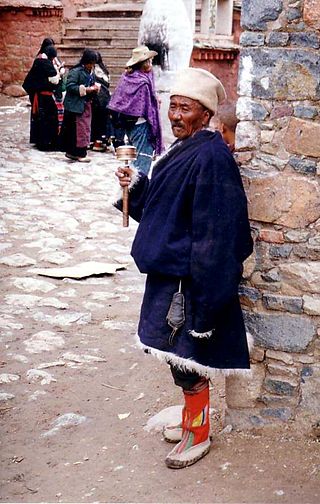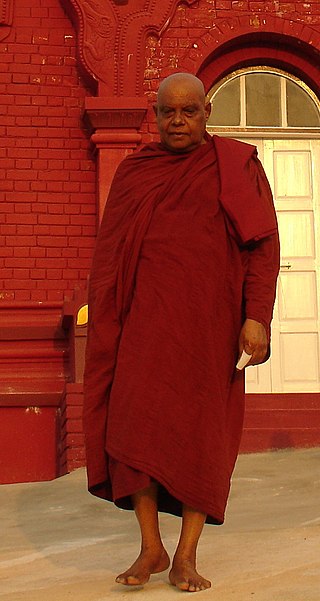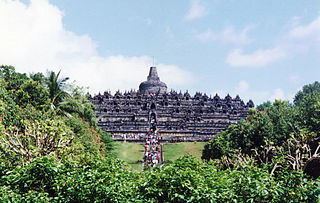
In Buddhism, the Four Noble Truths are "the truths of the Noble Ones", the truths or realities for the "spiritually worthy ones". The truths are:
Theravāda is the most commonly accepted name of Buddhism's oldest existing school. The school's adherents, termed Theravādins, have preserved their version of Gautama Buddha's teaching or Buddha Dhamma in the Pāli Canon for over two millennia.
In Buddhism, the three marks of existence are three characteristics of all existence and beings, namely aniccā (impermanence), dukkha, and anattā. That humans are subject to delusion about the three marks, that this delusion results in suffering, and that removal of that delusion results in the end of dukkha, is a central theme in the Buddhist Four Noble Truths and Noble Eightfold Path.
Taṇhā is an important concept in Buddhism, referring to "thirst, desire, longing, greed", either physical or mental. It is typically translated as craving, and is of three types: kāma-taṇhā, bhava-taṇhā, and vibhava-taṇhā.

Maudgalyāyana, also known as Mahāmaudgalyāyana or by his birth name Kolita, was one of the Buddha's closest disciples. Described as a contemporary of disciples such as Subhuti, Śāriputra, and Mahākāśyapa, he is considered the second of the Buddha's two foremost male disciples, together with Śāriputra. Traditional accounts relate that Maudgalyāyana and Śāriputra become spiritual wanderers in their youth. After having searched for spiritual truth for a while, they come into contact with the Buddhist teaching through verses that have become widely known in the Buddhist world. Eventually they meet the Buddha himself and ordain as monks under him. Maudgalyāyana attains enlightenment shortly after that.

Bhikkhu Bodhi, born Jeffrey Block, is an American Theravada Buddhist monk ordained in Sri Lanka. He teaches in the New York and New Jersey area. He was appointed the second president of the Buddhist Publication Society and has edited and authored several publications grounded in the Theravada Buddhist tradition.

Burmese pagodas are stupas that typically house Buddhist relics, including relics associated with Buddha. Pagodas feature prominently in Myanmar's landscape, earning the country the moniker "land of pagodas." According to 2016 statistics compiled by the State Sangha Maha Nayaka Committee, Myanmar is home to 1,479 pagodas exceeding 27 feet (8.2 m) in height, a quarter of which are located in Sagaing Region. Several cities in the country, including Mandalay and Bagan, are known for their abundance of pagodas. Pagodas are the site of seasonal pagoda festivals.
The Mahamevnawa Buddhist Monastery (MBM) is an organization of Buddhist monasteries of Sri Lankan origin established under the teachings of Gautama Buddha. Its main monastery is in Polgahawela, Sri Lanka.

The most important places in Buddhism are located in the Indo-Gangetic Plain of southern Nepal and northern India. This is the area where Gautama Buddha was born, lived, and taught, and the main sites connected to his life are now important places of pilgrimage for both Buddhists and Hindus. Many countries that are or were predominantly Buddhist have shrines and places which can be visited as a pilgrimage.
In Buddhism, the bodhipakkhiyā dhammā are qualities conducive or related to awakening/understanding, i.e. the factors and wholesome qualities which are developed when the mind is trained.
The Buddha was born into a noble family in Lumbini in 563 BCE as per historical events and 624 BCE according to Buddhist tradition. He was called Siddhartha Gautama in his childhood. His father was king Śuddhodana, leader of the Shakya clan in what was the growing state of Kosala, and his mother was queen Maya. According to Buddhist legends, the baby exhibited the marks of a great man. A prophecy indicated that, if the child stayed at home, he was destined to become a world ruler. If the child left home, however, he would become a universal spiritual leader. To make sure the boy would be a great king and world ruler, his father isolated him in his palace and he was raised by his mother's younger sister, Mahapajapati Gotami, after his mother died just seven days after childbirth.
Aggamahāpaṇḍita is an honorific Burmese Buddhist title conferred by the Myanmar government to distinguished Theravada Buddhist monks.

Most Ven. Nauyane Ariyadhamma Maha Thera was a Sri Lankan bhikkhu and a senior meditation teacher. He was the spiritual advisor of the Sri Kalyani Yogasrama Samstha, and for many years resided at the Na Uyana Aranya. In 2011 he moved to Meetirigala Dharmayatanaya to help revitalize this long-standing place of learning and dhamma practice.
Dambagasare Sri Sumedhankara Thero was a Buddhist monk from Sri Lanka who re-discovered the Seruvila Mangala Raja Maha Viharaya temple in 1922.

Bodagama Chandima Thero is a Buddhist monk. As of 2015 he taught Theravada Buddhism in Taiwan. With a group of Taiwanese Buddhists, he founded the Theravada Samadhi Education Association in Taipei.

Sanghyang Adi Buddha is a concept of God in Indonesian Buddhism. This term was used by Ashin Jinarakshita at the time of Buddhist revival in Indonesia in the mid-20th century to reconcile the first principle of the official philosophical foundation of Indonesia (Pancasila), i.e. Ketuhanan Yang Maha Esa that requires the belief in a supreme God, which Buddhism, strictly speaking, does not believe in. This concept is used by the Indonesian Buddhist Council, an organization that seeks to represent all Buddhist traditions in Indonesia such as Theravada, Mahayana, and Vajrayana.

Hikkaduwe Sri Sumangala Thera was a Sri Lankan Buddhist monk, who was one of the pioneers of Sri Lankan Buddhist revivalist movement in the 19th century. He did a great service to improve the Buddhist Education in the country and was the founder of Vidyodaya Pirivena, Maligakanda in 1873, which was granted the university status later in 1959 by the Government of Sri Lanka. A veteran author and a fiery orator, he was a major figure in the Panadurawadaya, a religious debate held between Christian missionaries and Buddhist monks in 1873 at Panadura, Sri Lanka. He was well versed in Sinhala, Pali, Sanskrit, English, Buddhism, history, arithmetic, and archaeology and was one of the primary sources of information on Buddhism for the success of the Panadura debate.
Shraddha TV is a non-profit Buddhist television channel based in Sri Lanka. The channel is known for airing religious spiritual content with a primary focus on Buddhism and the teaching of Buddha. Most of the programming is shot at the main Buddhist monastery in Polgahawela.









